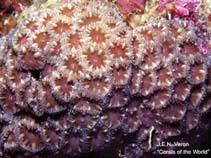Blastomussa wellsi Wijsman-Best, 1973
Branched cup coral| Native range | All suitable habitat | Point map | Year 2050 |

|
| This map was computer-generated and has not yet been reviewed. |
| Blastomussa wellsi AquaMaps Data sources: GBIF OBIS |
Classification / Names Common names | Synonyms | CoL | ITIS | WoRMS
Anthozoa | Scleractinia | Plerogyridae
Environment: milieu / climate zone / depth range / distribution range Ecology
Reef-associated; depth range 0 - 50 m (Ref. 115153). Tropical; 37°N - 26°S, 32°E - 175°W (Ref. 848)
Distribution Countries | FAO areas | Ecosystems | Occurrences | Introductions
Indo-West Pacific: Red Sea, Malaysia to Polynesia, north to Japan and south to Australia.
Length at first maturity / Size / Weight / Age
Maturity: Lm ? range ? - ? cm
Short description Morphology
Formation: phaceloid, rarely subplocoid. Corallite diameter: between 9 to 14 mm. Numerous septa not arranged in cycles. Mantles extend during the day and may form a continuous surface obscuring the underlying growth-form. Color: mantles are usually gray, but also red or green; oral discs are usually green, but also red or dark gray (Ref. 848).
Mainly lives in wave-exposed environments (Ref. 115153). Occurs in lower reef slopes away from wave action, also in turbid environments (Ref. 848).
Life cycle and mating behavior Maturity | Reproduction | Spawning | Eggs | Fecundity | Larvae
Members of the class Anthozoa are either gonochoric or hermaphroditic. Mature gametes are shed into the coelenteron and spawned through the mouth. Life cycle: The zygote develops into a planktonic planula larva. Metamorphosis begins with early morphogenesis of tentacles, septa and pharynx before larval settlement on the aboral end.
Main reference
References | Coordinator | Collaborators
Veron, J.E.N. and G. Hodgson. 1989. (Ref. 8817)
IUCN Red List Status (Ref. 130435)
Near Threatened (NT) ; Date assessed: 01 January 2008
CITES status (Ref. 108899)
Appendix II: International trade monitored
CMS (Ref. 116361)
Not Evaluated
Threat to humans
Human uses
| FishSource |
Tools
More information
Internet sources
BHL | BOLD Systems | CISTI | DiscoverLife | FAO(Publication : search) | Fishipedia | GenBank (genome, nucleotide) | GloBI | Gomexsi | Google Books | Google Scholar | Google | PubMed | Hexacorallians of the World | Tree of Life | Wikipedia (Go, Search) | Zoological Record
Estimates based on models
Preferred temperature
(Ref. 115969): 24.7 - 29, mean 27.8 (based on 784 cells).
Price category
(Ref. 80766):
Unknown.



